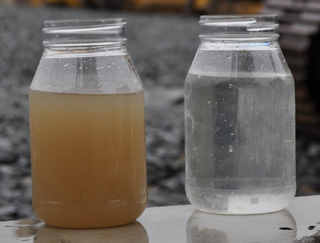|
Subscribe / Renew |
|
|
Contact Us |
|
| ► Subscribe to our Free Weekly Newsletter | |
| home | Welcome, sign in or click here to subscribe. | login |
Environment
| |
 |
September 27, 2012
Bringing clarity to stormwater management policy
SoundEarth Strategies

Hardebeck
|
Stormwater management has come a long way over the last decade, and the Northwest is leading some of the most stringent and difficult stormwater management challenges anywhere.
Stormwater policy is driven not only by the Clean Water Act, but also by endangered species, site cleanup initiatives, lawsuits, and efforts to manage source inputs to Superfund cleanups.
In 2008, National Pollution Discharge Elimination System (NPDES) permits took a major shift due to a ruling by the Ninth Circuit Court responding to a lawsuit which claimed the permits were not stringent enough to prevent further degradation of receiving waters and therefore violated the Clean Water Act. The court required the Environmental Protection Agency to prescribe effluent limitation guidelines to stormwater discharges, similar to wastewater, that comply with the intent of the Clean Water Act.
An analysis performed by the National Research Council later that year found that inputs to multiple watersheds exceeded the prescribed total maximum daily loads, often significantly.
The report stated: “Radical changes to the U.S. Environmental Protection Agency’s stormwater program are necessary to reverse degradation of fresh water resources and ensure progress toward the Clean Water Act’s goal of ‘fishable and swimmable’ waters…”
This is resulting in increased enforcement by the EPA and the movement towards multiple stakeholder responsibility for inputs into sensitive waters, which has motivated some of the focus of local policy.
Washington regulatory update
This year has produced a lot of change with the NPDES permits for industrial and municipal permittees. One of the more significant changes was the revision of the Western Washington Stormwater Management Manual. The manual was revised to bring more clarity and continuity to the requirements of the permits, but more importantly to incorporate the concepts of low-impact development as management tools for runoff control.
Businesses that have an NPDES permit for stormwater discharge have dealt with management challenges since the permit release in 2010. However, it is only recently, after all the arguments have been settled and the permit has gone through final modification, that businesses have to take significant action towards compliance.
Ecology’s modifications to the permit focused on three areas: monitoring, corrective actions, and dischargers to 303(d) listed waters for fecal coliform. Previously, if sampling of a particular parameter was below benchmark four consecutive quarters, then the sampling for that parameter could be suspended. As of July 1, those that suspended their sampling program due to attainment need to achieve another four consecutive samples below benchmark to suspend sampling again.
Ecology also recognized that the best management practices (BMPs) selected for a corrective action often did not have adequate time to change discharge water quality before the permittee was moving towards another, more aggressive BMP. The modification to the permit allows permittees to actually get performance from their BMP prior to compounding other corrective actions.
The new municipal permit released in August requires the use of low-impact development “where feasible.” For new development, cities and counties will need to justify why diversion and/or permeable surfaces are not feasible to the development of the site. Municipalities will also need to implement educational outreach to new audiences.
There is also an emphasis for municipalities to have a better understanding of the quality of water that is discharging from their jurisdiction. To aid in that understanding, municipalities will pay into a regional monitoring program or operate self-performed monitoring programs. With a nationwide focus to hold water quality to total maximum daily load standards, these monitoring results will likely result in further discussion with regards to effectiveness and efficiencies of municipal stormwater programs.
As municipalities are held more responsible for the water quality flowing through their stormwater system, it will cause them to ensure the water discharging through private storm systems is not causing them additional cost or liability.
For more details on Washington’s NPDES permit program visit http://www.ecy.wa.gov/programs/wq/stormwater.
Other regulatory drivers
Lawsuits. Citizen group enforcement is definitely on the rise. There are several active groups in the Northwest and they are motivating change through filing lawsuits against businesses and municipalities that are not doing enough, in their minds, to control stormwater runoff.
Paperwork not submitted or neglected is often the primary reason the groups get involved with permit holders. Due to the fact that most permits require online reporting, the data is readily available and easily accessed.
As new standards based on human health and water quality criteria are developed, it can only be anticipated that the trend of citizen groups motivating change through lawsuits will continue to increase.
Fish consumption rate. How much fish we eat may aid in determining the water quality discharged into our receiving waters.
Pollutants and toxins in the water and sediment of the receiving waters can be absorbed or ingested by fish and shellfish. Recent studies in Washington indicate that we consume somewhere between 20 and 40 times the amount of fish than previously thought. This could result in a similar magnitude reduction of pollutants allowed to enter into receiving waters.
With benchmark standards already being very low and difficult to achieve, municipalities and industry are concerned that stormwater control will cost hundreds of millions of dollars annually to reduce pollutants to the level that human and biological health requires.
Sediment standards and total daily maximum loads. Regulatory agencies learned a large lesson with the cleanup of the Thea Foss Waterway. Hundreds of millions of dollars were spent on cleanup of the waterway — only to have it recontaminated in a very short period of time, primarily from surface water inputs.
The Thea Foss created the first connection between the Comprehensive Environmental Response, Compensation and Liability Act and NPDES. Other cleanup efforts — such as the Columbia River, Portland Harbor and Lower Duwamish Waterway — have the potential to require those that contribute runoff to more aggressively manage their runoff to prevent recontamination.
Ecology has recently made requests of all industrial stormwater general permit holders to resubmit their stormwater pollution prevention plans for review. The goal is to assure that there is an active pollution prevention program in place and steps are being taken to control runoff.
Ecology is seeking public comment until Oct. 15 on the revised Sediment Management Standards. The proposed changes are meant to clarify requirements for cleanup of contaminated sediment sites and to make the cleanup process more effective.
Management approaches
There is a new trend in stormwater management to try and evaluate the stormwater system as a whole, rather than just identify the “hot spots” or areas of concern. Water does not follow jurisdictional boundaries. Management of the drainage basin can be completely different as water flows downhill.
The question: Is the management of the inputs to the system effective at reducing pollutants to a level that does not degrade the water resource? If everyone is managing the inputs differently and for different criteria, the health of the water body is secondary to ensuring compliance with the discharge from each source.
Regulatory agencies are taking a step-back; looking at the structure of the NPDES permit system to see if the permits are actually achieving a desired result of anti-degrading water quality. Watershed- or drainage basin-based permitting is being explored and pilot tests are under way in other places in the country.
Source control remains a central focus of stormwater management, such as requesting manufacturers to look for alternative production techniques and product compositions that reduce water pollutants. Sampling techniques and methodologies are changing to reflect the need to accrue accurate and defensible data, from which good management decisions can be made. The focus of treatment BMPs in the last few years has really gone in two directions: green infrastructure and advanced treatment.
Green infrastructure techniques are used primarily in redevelopment situations to help with volume control and pollution reduction.
Advanced treatment systems use flocculants, electro-coagulation or specialized filtration media, and are demonstrating the ability to reduce pollutants in the parts per billion range.
It was only about 10 years ago that we were arguing whether “stormwater” was one word or two. Now, we are talking about phthalates and endocrine disruptors in stormwater runoff. What hasn’t changed in that time period are statements such as: “Stormwater is the leading cause of water pollution in the U.S.”
Until we can change that statement, we can only anticipate that more regulations, with tighter controls will be placed on those responsible for stormwater management controls.
Stormwater management is becoming part of our everyday decision making for how we operate our businesses, manage our surface streets, and develop our properties.
Nathan Hardebeck has more than 12 years of experience in the environmental consulting field with an emphasis on program development and management related to stormwater services. He provides training and technical expertise for stormwater policy management, as well as working on behalf of private clients and industries on their management, sampling and BMP programs.
Other Stories:
- Small businesses prevent pollution, save money
- Surveys 2012: Paladino & Co.
- Surveys 2012: Aspect Consulting
- Surveys 2012: HWA GeoSciences
- Surveys 2012: Confluence Environmental Co.
- Surveys 2012: Climate Solutions
- Surveys 2012: CH2M Hill
- Surveys 2012: Herrera Environmental Consultants
- Lean processes could change the construction industry
- Getting stormwater back into the ground
- Park(ing) Day provides parallel green objectives
- Fewer projects will need environmental review
- Tapping into wastewater plants for renewable energy
- How urban agriculture can help grow the economy
- Blending two projects puts dredge spoils to good use
- What it takes to compete in the New Economy
- System scrubs contaminated groundwater at Hanford
- Surveys 2012: Integral Consulting



